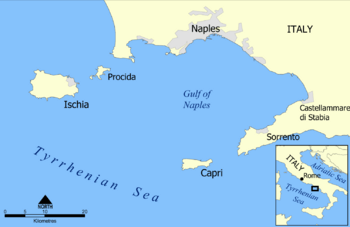Capri facts for kids

View of Capri from the sea
|
|
 |
|
| Geography | |
|---|---|
| Location | Tyrrhenian Sea |
| Area | 10.4 km2 (4.0 sq mi) |
| Highest elevation | 589 m (1,932 ft) |
| Administration | |
|
Italy
|
|
| Demographics | |
| Population | 12,200 |
| Pop. density | 1,170 /km2 (3,030 /sq mi) |
Capri is a beautiful island in Italy. It's in the Tyrrhenian Sea, near the Sorrentine Peninsula and the Gulf of Naples. The main town on the island is also called Capri. People have been visiting Capri for fun holidays since the time of the ancient Roman Republic!
Capri is part of the Campania region and the Province of Naples. The island has two harbours: Marina Piccola (the small harbour) and Marina Grande (the main port). Another town, Anacapri, is located high up on the hills.
The island of Capri is mostly made of limestone and sandstone rock. Its sides are steep cliffs, and the surface also has many cliffs. The meaning of the name 'Capri' is not fully known.
Contents
Discovering Capri's Amazing Features
Capri is famous for many cool places. One is the Marina Piccola, a charming little harbour. There's also the Belvedere of Tragara, a high walkway with amazing views and fancy houses.
What Makes Capri Special?
You'll see tall limestone rocks called Faraglioni sticking out of the sea. These are like natural sculptures! The town of Anacapri is another key spot. Don't miss the Blue Grotto (Grotta Azzurra), a sea cave with glowing blue water. You can also explore the old ruins of Roman villas.
Visiting Capri: A Popular Island Getaway
Capri is a very popular place for tourists from Italy and other countries. In the 1950s, it became a famous holiday spot. During summer, many visitors come to the island. Lots of them are day-trippers from nearby Naples and Sorrento. The main meeting point in Capri is the Piazza, a lively square.
Nature and Wildlife on Capri
Capri is home to special plants like the Mediterranean bush and the Arboreal Euphorbia. You can also find Ilex Wood here. The island has many animals too! Look out for quails, robins, and peregrine falcons. You might also spot blackbirds, geckos, and even blue lizards on the Faraglioni rocks. In the sea, there are red goldfish, conger eels, and groupers.
Famous Attractions and Landmarks
Capri has twelve churches, seven museums, and several monuments. The most visited place is the Blue Grotto. This amazing sea cave was found in the 1800s by tourists. It has been a popular sight ever since. Inside the grotto, you can see ancient Roman rock remains and a narrow opening.
Images for kids
-
The remains of Villa Jovis, built by emperor Tiberius and finished in AD 27
-
In 1909–1911 Maxim Gorky lived on Capri at villa Behring (burgundy).
See also
 In Spanish: Isla de Capri para niños
In Spanish: Isla de Capri para niños









